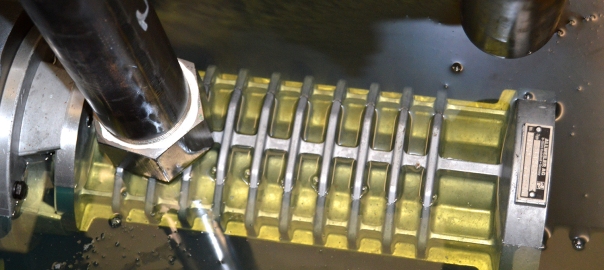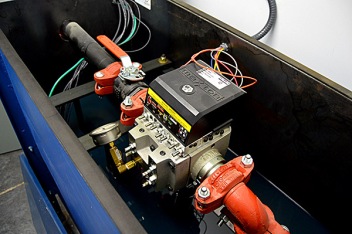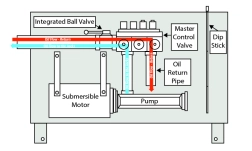I found this in my email and it has some great information. This is a repost from https://schmelevator.wordpress.com.

The anatomy of a hydraulic power unit
 When it comes to hydraulic elevators, there is a crucial piece of the system that often goes unnoticed. It gets little attention because on the outside, it looks like a big rectangular box.
When it comes to hydraulic elevators, there is a crucial piece of the system that often goes unnoticed. It gets little attention because on the outside, it looks like a big rectangular box.
Little do most people know that this box is actually filled with the components and the oil that make the elevator move. Without the tank and all of the parts inside, the jacks won’t go up or down and the elevator won’t move. So let’s peek inside the box and see what makes everything work.
The hydraulic tank consists of the following components:
- Tank
- Submersible Motor
- Pump
- Master Control Valve
- Negative Pressure Switch
- Integrated Ball Valve
- Vibration Damping Mount
- Dip Stick
- Oil Return
- Muffler
- Hydraulic Oil

Tank – The tank has the primary purpose of holding the oil that raises the elevator, but it also houses the other important components. The size of the tank is dependent upon the number of floors and the components required, and Phoenix Modular Elevator has several sizes of hydraulic tanks to meet any need. In general terms, most two-stop elevator tanks hold approximately 80 gallons of oil.
Submersible Motor – One of the reasons that a tank seems so unremarkable is that the primary components all fit inside the tank, including a motor designed to remain submerged in hydraulic oil. The motor powers the pump that pushes the jack up, while gravity does the work coming down.
Pump – In a hydraulic elevator, the main function of the pump is to push the oil into the jack to lift the elevator. The pump is submersible and attached to the master control valve with a length of pipe called the pump/valve connection pipe. When powered by the motor, the pump pushes the oil through the valve and into the cylinder (jack) or hydraulic jack system.
Master Control Valve – This valve is where the motion profile is set, which is a fancy way of saying this component makes the elevator run smoothly, efficiently and safely when delivering its payload. Without properly setting this valve, the elevator would either run too fast or too slow without easing into starting and stopping. This would increase Dramamine sales but decrease the enjoyment and safety of the elevator ride.
Negative Pressure Switch – Part of the master control valve, this switch ensures there is always pressure in the system so the hydraulic elevator will not fall rapidly due to decreasing pressure. Keep in mind, failure of a hydraulic elevator is rare and this component makes it even less likely there will be any unexpected drops.
Integrated Ball Valve – This is a shutoff valve located in or just outside the tank between the master control valve and the pipe that leads to the hydraulic jack. The purpose is to give licensed elevator mechanics a way to conveniently and safely shut off the flow of oil when servicing the elevator or replacing parts.
Vibration Dampening Mount – With a motor and pump powerful enough to lift an elevator, there has to be a little bit of shakin’ goin’ on. To combat the bad vibes, everything is mounted on pieces of metal suspended by neoprene donuts that cushion the parts and reduce shaking.
Dipstick – Inserted in every tank is a dipstick that has markings to indicate the maximum and minimum oil levels required for safe operation.
Oil Return – When the elevator comes down, gravity does the work, but the oil has to get back to the tank. To do this, the oil returns to the tank in the same pipes it went out until it gets to the master control valve. Once there, the valve again regulates the speed of the descent by controlling the flow of oil back into the tank.
Muffler – The oil flows in pulses and can create vibrations and loud sounds. To combat this, a muffler is placed either in the tank or just outside the tank to quiet the flow pulses and minimize noise.
Hydraulic Oil – Hydraulic oil used to be petroleum based but now vegetable based oil is also available to ensure it is environmentally safe should a leak occur.
To function properly, the tank should be set level, be free from leaks, be set away from walls and be clean. Also, the tank should be in a climate-controlled machine room. The tank is the heart of the hydraulic elevator and needs to be cared for to ensure a long life of dependable service.
Repost from - https://schmelevator.wordpress.com
If
you have any questions or would like information from Colley Elevator you can
go to www.colleyelevator.com, email Craigz@colleyelevator.com or call 630-766-7230.

Does Ufone Have 3G Coverage In Kamaliya?
ReplyDeleteDoes Ufone Have 3G Coverage In Jhelum?
Does Ufone Have 3G Coverage In jhang?
Does Ufone Have 3G Coverage In Jhauharabad?
Does Ufone Have 3G Coverage In Jaranwala?
Thanks for posting the useful information to my vision. This is excellent information,.
ReplyDeletefull height turnstiles in mumbai,automatic gates in mumbai,road blocker in mumbai,boom barriers in mumbai,hydraulic rising bollards in mumbai
Thank you for your post. This is excellent information. It is amazing and wonderful to visit your site.
ReplyDeletehydraulic rising bollards
rising bollards
hydraulic road blockers in delhi
ReplyDeleteThank you for your post. This is excellent information. It is amazing and wonderful to visit your site.
rising bollards in delhi
automatic bollards in delhi
rising bollards in chennai
automatic bollards in delhi
rising bollards
automatic bollards in Hyderabad
Hello! Nice column! Thank you for sharing. I recommend haircut here. Have a nice day.
ReplyDeleteДоброе утро! Обращаем ваше внимание на справочник выпускаемых медпрепаратов. В путеводитель входят сведения о свыше семистах современных медпрепаратах, производимых отечественными и иностранными фармкомпаниями. О любом лекарстве дана подробная инфа: состав и форма выпуска, лечебные свойства, показания к применению, критерии использования, взаимодействие со спиртным, дополнительные побочные эффекты, противопоказания и взаимодействие остальными медикаментами, кроме того возможность использования при беременности, грудном вскармливании. В справочник введен тематический указатель, в котором находится инфа о том, какое медицинское средство следует применять при тех или иных заболеваниях, синдромах, состояниях. Справочное издание расположено на медицинском https://www.all-medications.ru/. Не болейте! Тимолол / пилокарпин, Напроксен, Эритритила тетранитрат, Тетрадецилсульфат натрия, Оксапрозин, Флуметазон / салициловая кислота,
ReplyDeleteПараллельно-раздвижные окна и двери – PSK-портал инсталлируются в целях сохранения незаполненного, свободного пространства. Обыкновенные виды раскрываются вовнутрь помещения, что занимает весьма большую часть места в комнате. Технологичные окна разрешают избежать данной проблемы, усилить световой и воздушный поток в помещении.
ReplyDeleteНаклонно-сдвижной портал являются системами, которые обладают весьма большой площадью стеклопакета. В целях обеспечения возможности сдвига створок присоединяются нижние и верхние полозья, с помощью которых механизм легко и бесшумно движется.
Раздвигание совершается с помощью ходовых роликов, кои содержат опору в качестве элементов армирования, позволяющим как можно более равномерно распределить массу по по всей раме. Они дают возможность створке окна передвигаться в различных режимах (наклона, сдвига).
Высота створки должна быть не более 2,36 метра, а ширина створки двери может меняться от 670 мм до 1,60 метра. С учетом суммарного веса (изменяется от 100 кг до 200 кг), на раздвижное окно ставится определенная фурнитура для обеспечения исправного открывания - закрывания створок, продления срока эксплуатации. Ширина свободного проема может достигать 2 метров.
Подъемно-сдвижные порталы обладают хорошими герметичными качествами, хорошими показателями звуко-, теплоизоляции, имеют должный уровень противовзломности, великолепно подходят для всех видов нынешних профилей. При установке используют опоясывающие щеточные уплотнители, кои заметно улучшают функционирование створок.
Если же вы хотите оформить большой загородный дом, городскую квартиру, балкон или лоджию согласно модным тенденциям в дизайне, то компания-изготовитель СВ Окна сделает и сделает монтаж параллельно-раздвижных окон и дверей.
Nice post...
ReplyDeleteBest Vehicle Loop Detector
Helpful info on rescue equipment! Check this hydraulic Power Pack.
ReplyDelete